Some of the easiest fish to care for are betta fish, zebra danios, and Corydoras catfish. Whether a hobbyist wants a single fish, a school, or a community, there are many easy fish to choose from.
These are some of the easiest fish because they are small, peaceful, and hardy. Many of the fish on this list can handle a wide range of temperatures and water parameters.
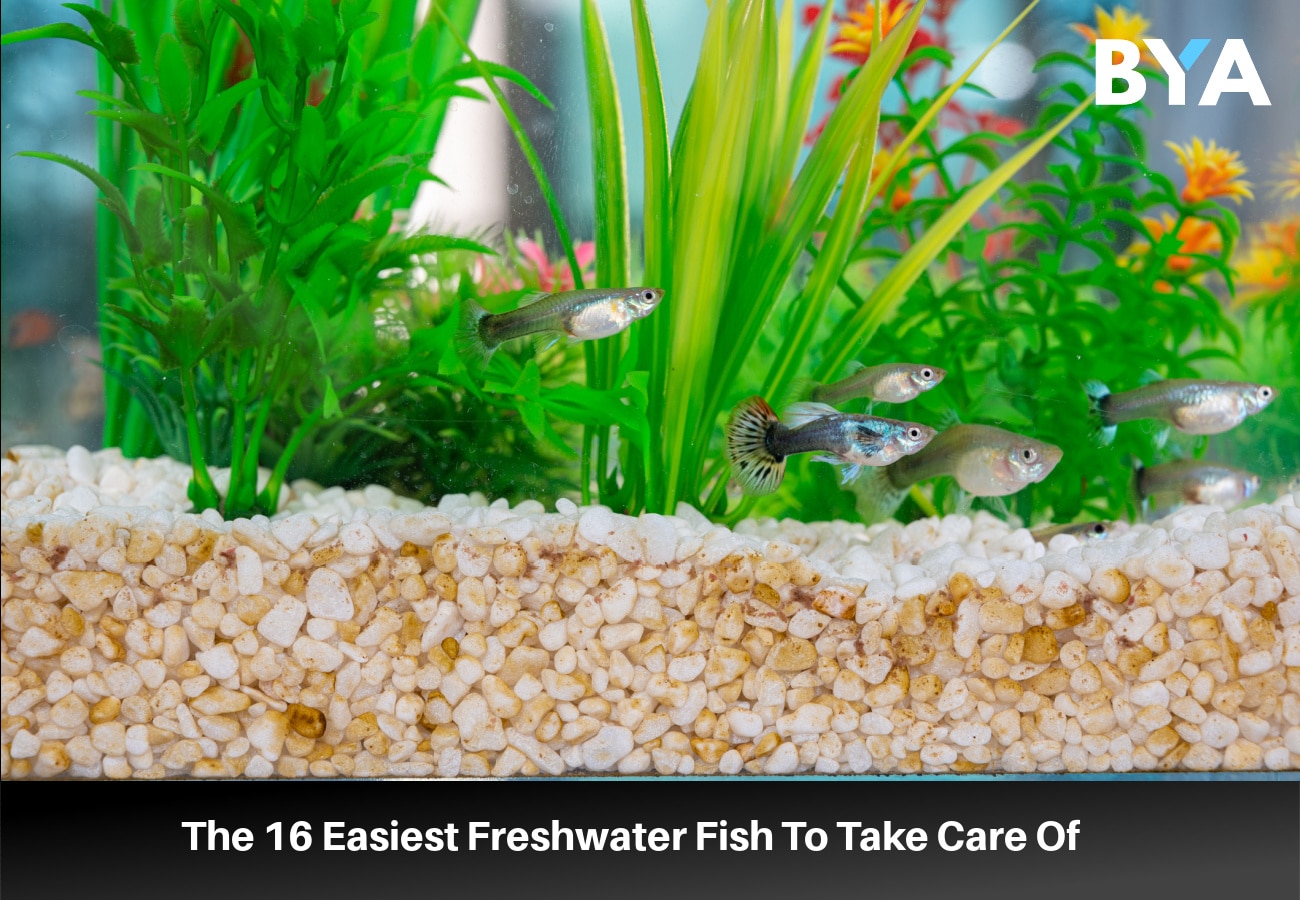
Low Maintenance Freshwater Fish
These 16 easy fish are perfect for anyone wanting a simple yet beautiful aquarium.
1. Betta Fish (Betta splendens)
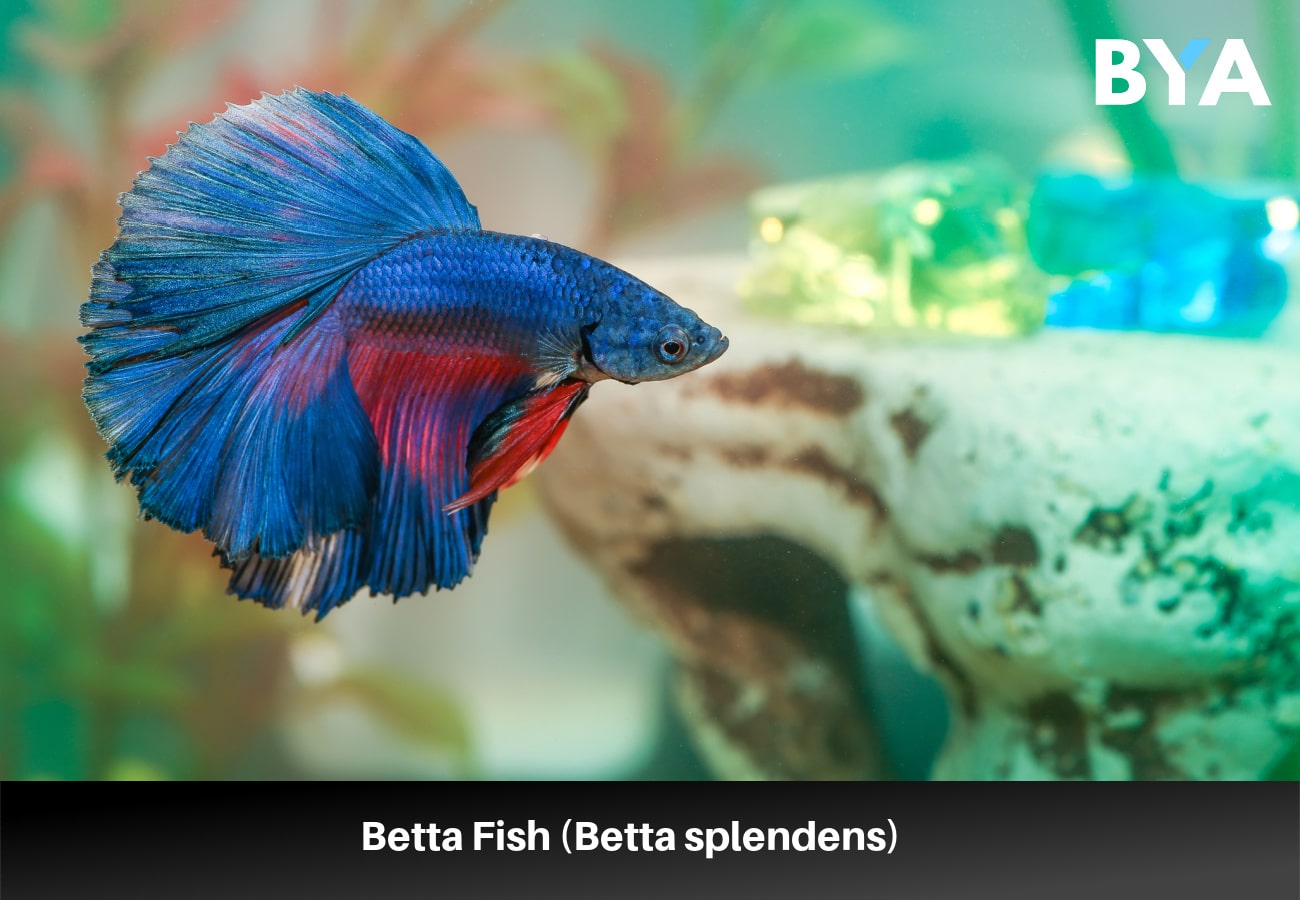
- Size: 2-3 in (5.1-7.6 cm)
- Aquarium Size: 5+ gallons
- Temperature Requirements: 75-81°F (23.9-27.2°C)
- pH Requirements: 6.5-7.5
- Swimming Level: Middle to Top
- Temperament: Semi-Aggressive
Betta fish are one of the most popular beginner fish available. They come in many vibrant colors and have long, flowing fins that make them mesmerizing.
Bettas are not overly picky about their pH levels, though they need warm water. They are friendly fish that enjoy interacting with their owners and can learn to do tricks.
They even get along with various peaceful freshwater species. Remember that they can’t live with other bettas.
Betta fish are more challenging than many pet stores make them out to be. They need proper care like any other fish. At the least, betta fish need 5 gallons of water, a filter, and a heater. Nutritious food, regular water changes, and testing help bettas live their fullest lives.
2. Black Skirt Tetras (Gymnocorymbus ternetzi)
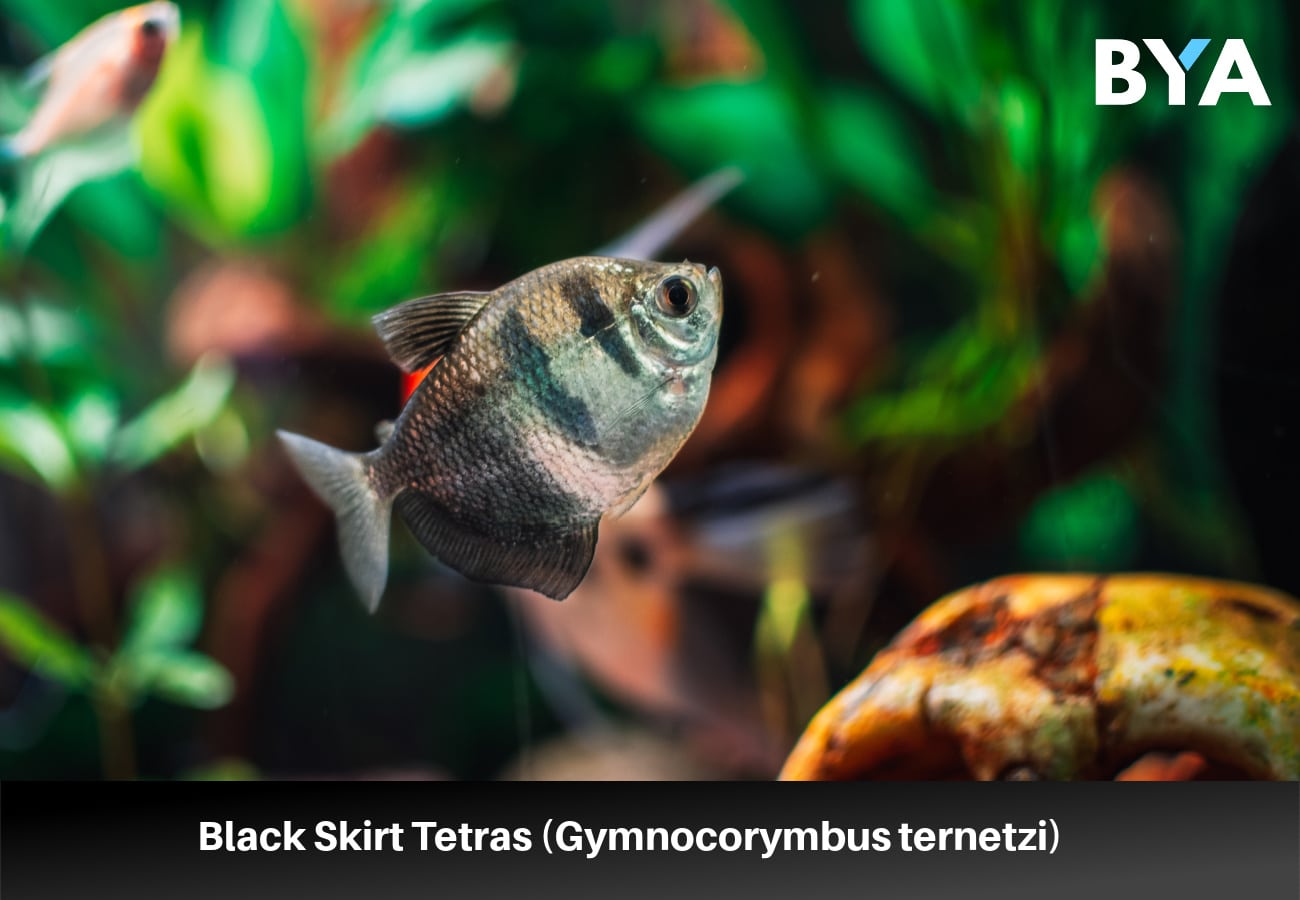
- Size: 2.5-3 in (6.4-7.6 cm)
- Aquarium Size: 15+ gallons
- Temperature Requirements: 72-80°F (22.3-26.7°C)
- pH Requirements: 6.0-7.0
- Swimming Level: Middle to Top
- Temperament: Peaceful
Black skirt tetras are the ideal easy fish for anyone looking for a larger tetra. Unlike most larger tetras, black skirts are peaceful and unlikely to nip at the fish around them.
These fish have long fins that resemble a skirt, and their bodies are a dark silvery-black.
Black skirt tetras are one of the hardiest tetra species. They prefer slightly acidic water and can withstand a range of warmer temperatures.
3. Bristlenose Plecos (Ancistrus cirrhosus)
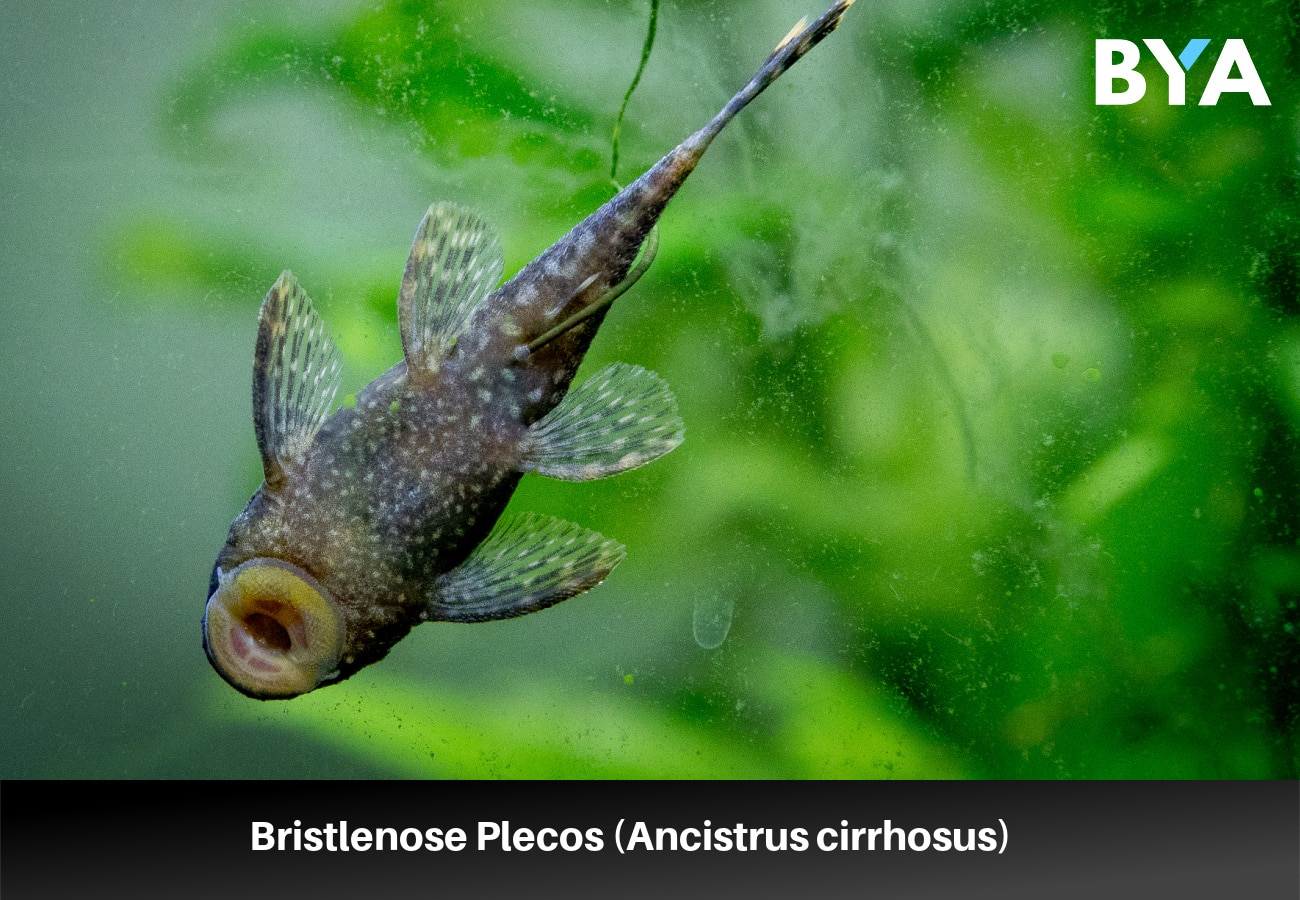
- Size: 3-5 in (7.6-12.7 cm)
- Aquarium Size: 30+ gallons
- Temperature Requirements: 60-80°F (16-27°C)
- pH Requirements: 6.5-7.5
- Swimming Level: Bottom
- Temperament: Peaceful
The bristlenose pleco is one of the easiest to care for of all the pleco species. They can tolerate slightly cold to warmer temperatures. They can also handle slightly acidic to alkaline water.
Bristlenose plecos work well with other peaceful community fish. They stay at the bottom and sides of the tank, where they feed on algae. They are gentle and will not attack other fish.
A pleco’s thick, armored bodies protect them from any semi-aggressive fish.
Bristlenose plecos produce more waste than other fish. Their tank needs cleaning about once a week. Also, make sure to feed them bottom-feeder food besides the algae around the tank.
4. Cherry Barbs (Puntius titteya)
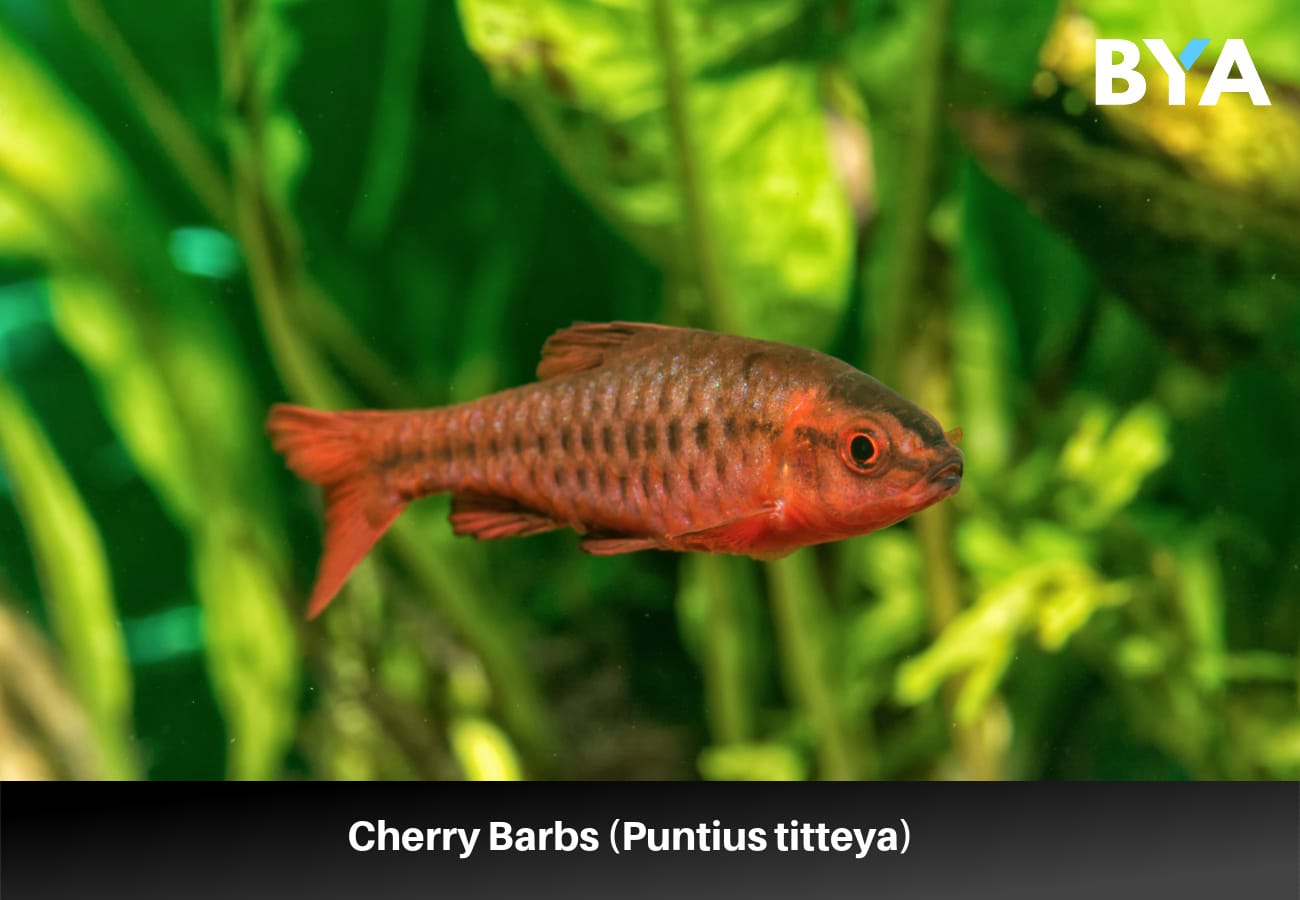
- Size: 2 in (5.1 cm)
- Aquarium Size: 20+ gallons
- Temperature Requirements: 74-80°F (23.3-26.7°C)
- pH Requirements: 6.0-7.0
- Swimming Level: Middle to Top
- Temperament: Peaceful
Cherry barbs are one of the best members of the barb species. Unlike most barbs, they are not aggressive or nippy. They get along with most peaceful freshwater fish.
Cherry barbs are more picky about pH and water temperature than some fish on this list.
Besides their peacefulness, cherry barbs are popular for their deep red coloration.
Cherry barbs are typically shy at first. They become more active once they become comfortable with their environment. They are schooling fish that must live in groups and enjoy having company.
5. Cory Catfish (Corydoras spp.)
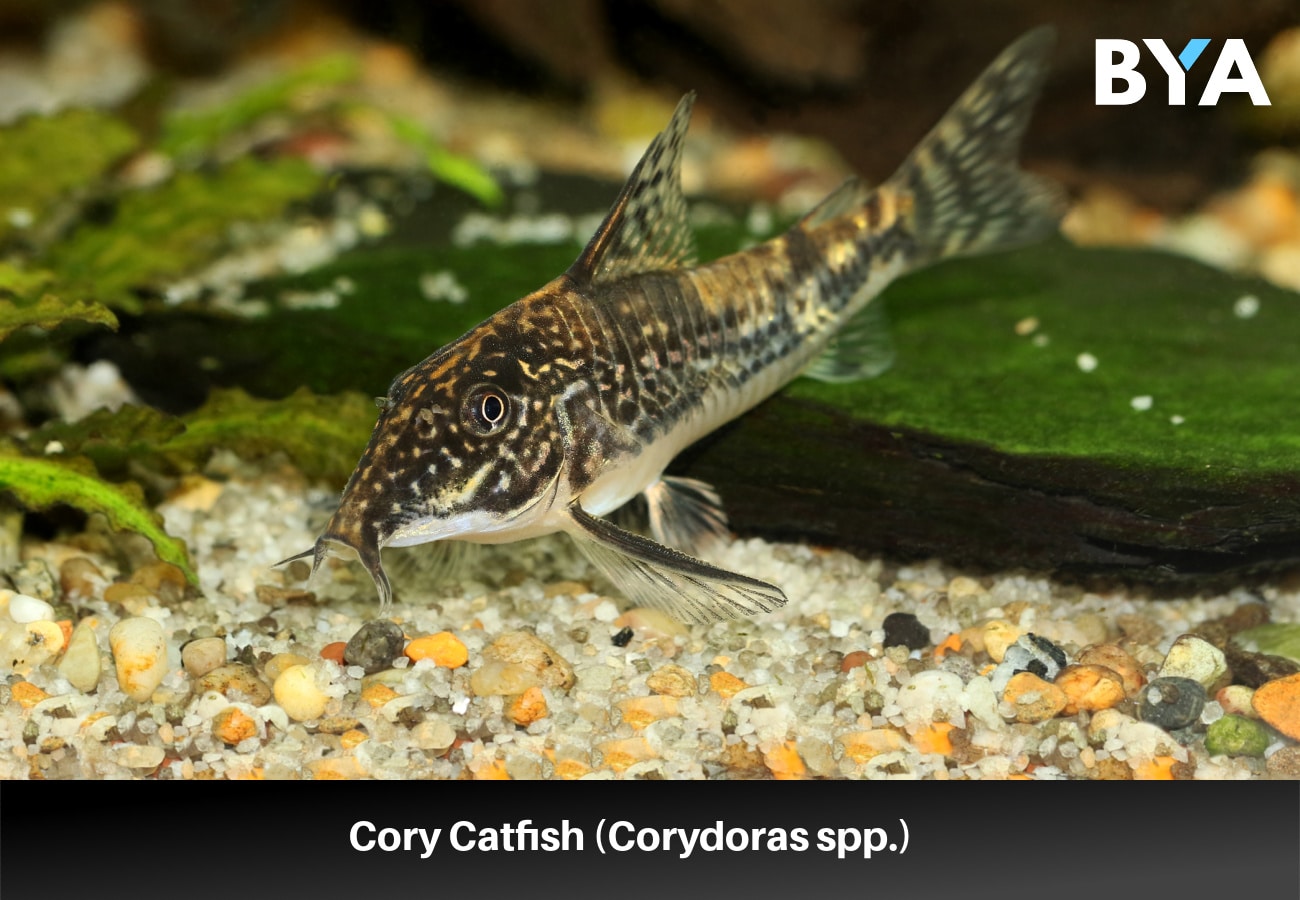
- Size: 1-5 in (2.5-12.7 cm)
- Aquarium Size: 20+ gallons
- Temperature Requirements: 70-80°F (21-27°C)
- pH Requirements: 6.0-8.0
- Swimming Level: Bottom
- Temperament: Peaceful
Corydoras catfish are among the easiest fish. They need little care and can handle many parameters. Cory cats can handle slightly acidic to alkaline water.
While cory cats need supplemental feeding, they are not as picky as many other species. They are happy to eat leftover fish food and other detritus on the bottom of the tank.
Corydoras work well in most peaceful and semi-aggressive community tanks. They stay out of the way of other fish.
Cory cats are bottom dwellers that enjoy hiding in caves and don’t bother the other fish around them.
These catfish are schooling animals that feel safe in the presence of their species. They are not picky, though, and will hang out with Corydoras of other varieties.
6. Dwarf Gouramis (Trichogaster lalius)
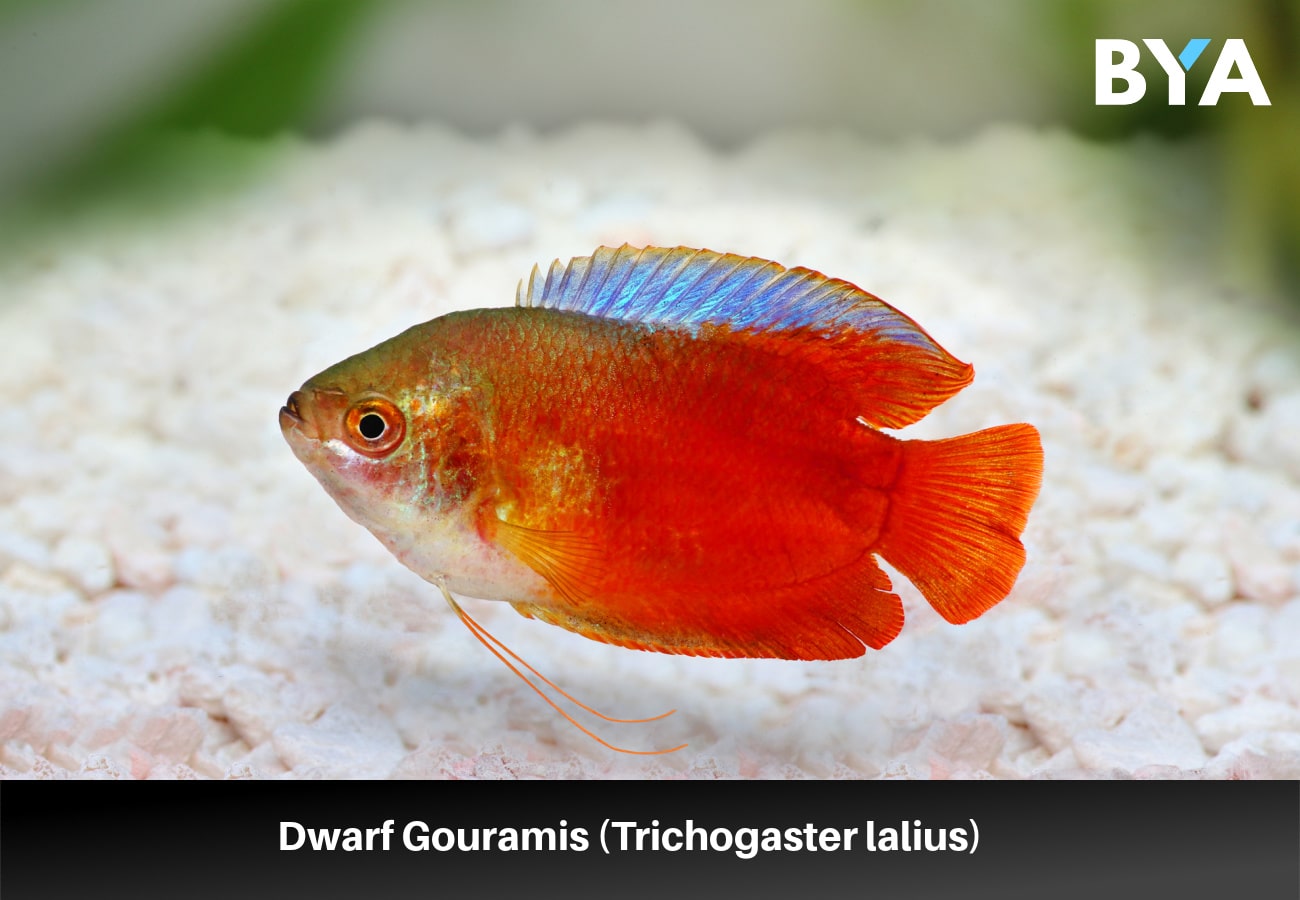
- Size: 3-5 in (7.6-12.7 cm)
- Aquarium Size: 20+ gallons
- Temperature Requirements: 72-82 °F (22.2-27.8°C)
- pH Requirements: 6.8-7.8
- Swimming Level: Middle to Top
- Temperament: Peaceful
Dwarf gouramis are peaceful as long as there is only one male per tank. They become territorial when there is more than one male gourami.
Females are friendly with one another. Males and females all get along with other peaceful species.
Dwarf gouramis are large enough to handle slight bullying from picky species.
Gouramis are popular in the freshwater aquarium hobby because of their vivid colors. They come in many hues, including iridescent blue and red.
Dwarf gouramis are relatives of betta fish. In the wild, they live in low-oxygen areas and use their labyrinth organs to get air from the surface. Due to their labyrinth organ, they do well in slow-moving waters without an airstone.
7. Guppies (Poecilia reticulata)
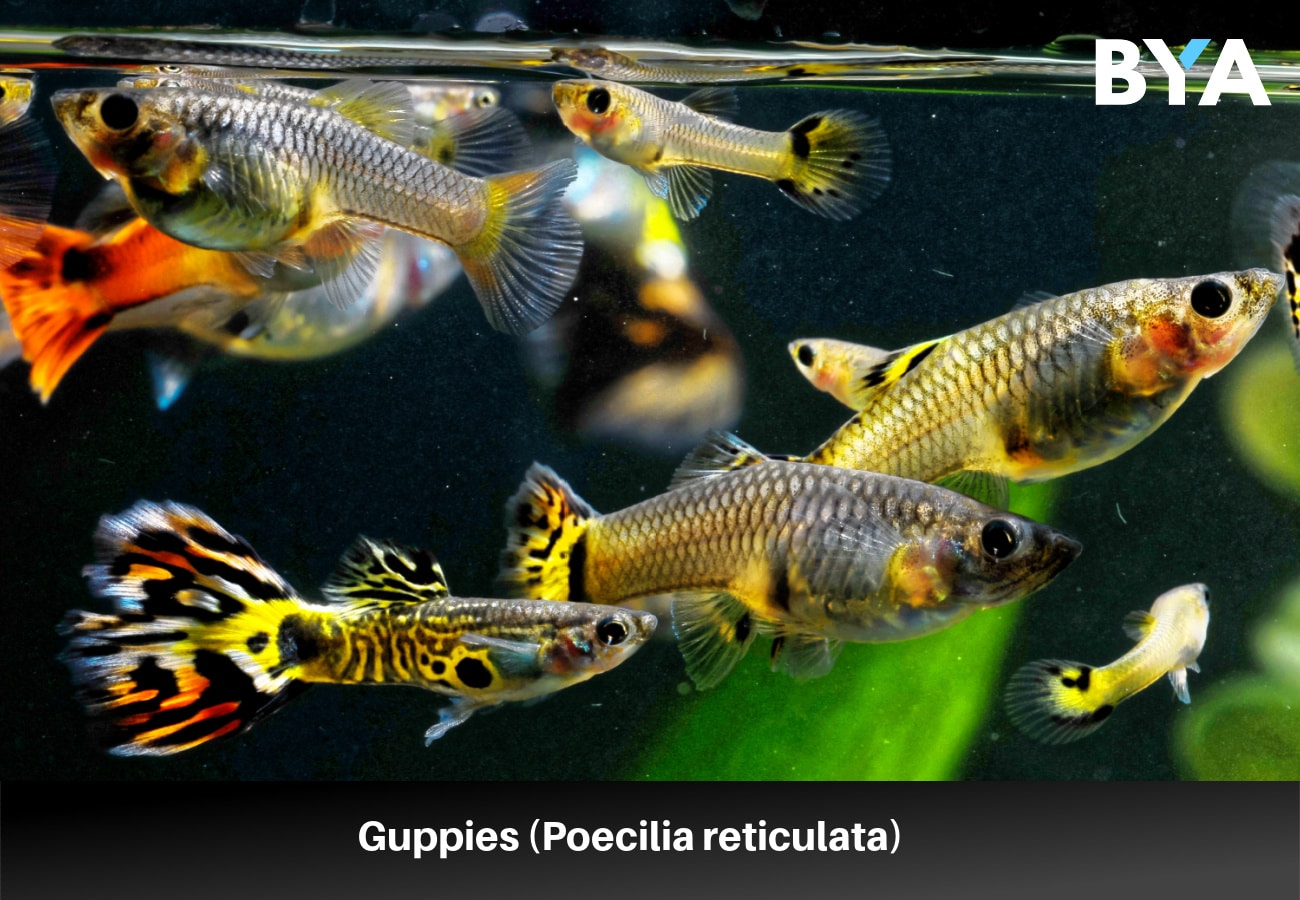
- Size: 2 in (5.1 cm)
- Aquarium Size: 10+ gallons
- Temperature Requirements: 72-82°F (22.2-27.8°C)
- pH Requirements: 6.8-7.8
- Swimming Level: Middle to Top
- Temperament: Peaceful
Guppies are easily the most popular livebearer for freshwater aquariums. They come in many vibrant colors, have long fins, and aren’t picky about water parameters.
These tiny fish do well in nano aquariums as small as 10 gallons. They are peaceful and get along with most other community freshwater fish.
Note that feeder guppies are far hardier than fancy guppies that were bred for their looks.
Feeder guppies are a grayish-brown color and are less pretty than fancy guppies. They are more durable and make a good choice for new aquarists.
True beginner aquarists should consider keeping all males or all females. As livebearers, guppies reproduce rapidly when males and females are in the tank. Fish fry are fun and rewarding, though they can be overwhelming for newbies. *
Those that are okay with babies should keep guppies in increments of three or more. Keep at least two females for every male in the tank. Having more females prevents the male from constantly harassing a single female.
8. Harlequin Rasboras (Trigonostigma heteromorpha)
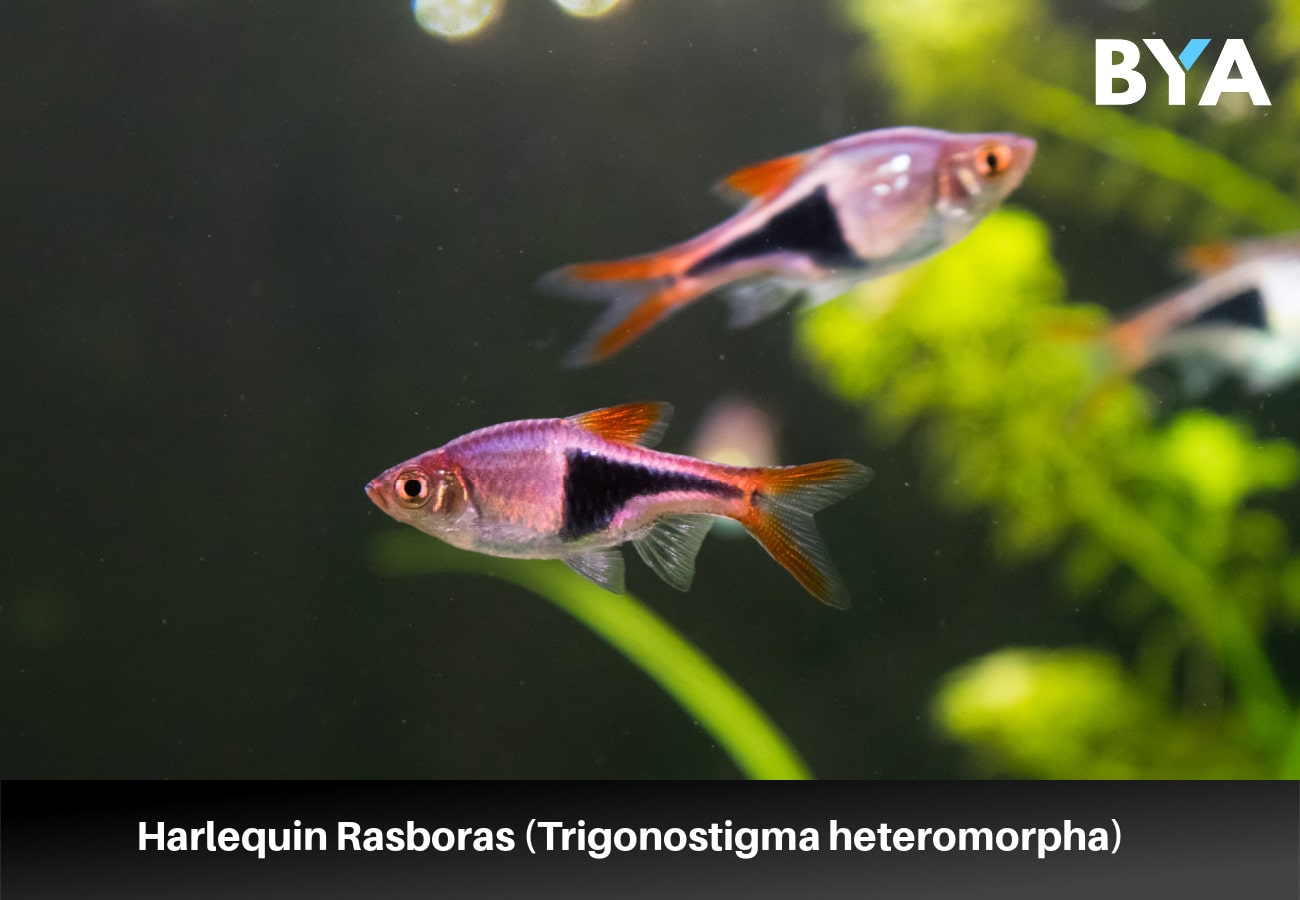
- Size: Up to 2 in (5 cm)
- Aquarium Size: 15+ gallons
- Temperature Requirements: 73-82°F (23-28°C)
- pH Requirements: 6.0-7.5
- Swimming Level: Middle to Top
- Temperament: Peaceful
Harlequin rasboras are famous for their light orange bodies and bright orange fins. The back ends of their bodies have an oblong, black triangle that helps them stand out in the aquarium.
Harlequin rasboras are among the easiest to care for; they tolerate various parameters. These rasboras are tropical fish that can live in warm to nearly hot temperatures. They are content in slightly acidic to neutral pH levels.
One of the most peaceful freshwater species, they are good for community tanks. Rasboras are schooling fish that enjoy being in their own company and that of other species.
9. Kuhli Loach (Pangio kuhlii)
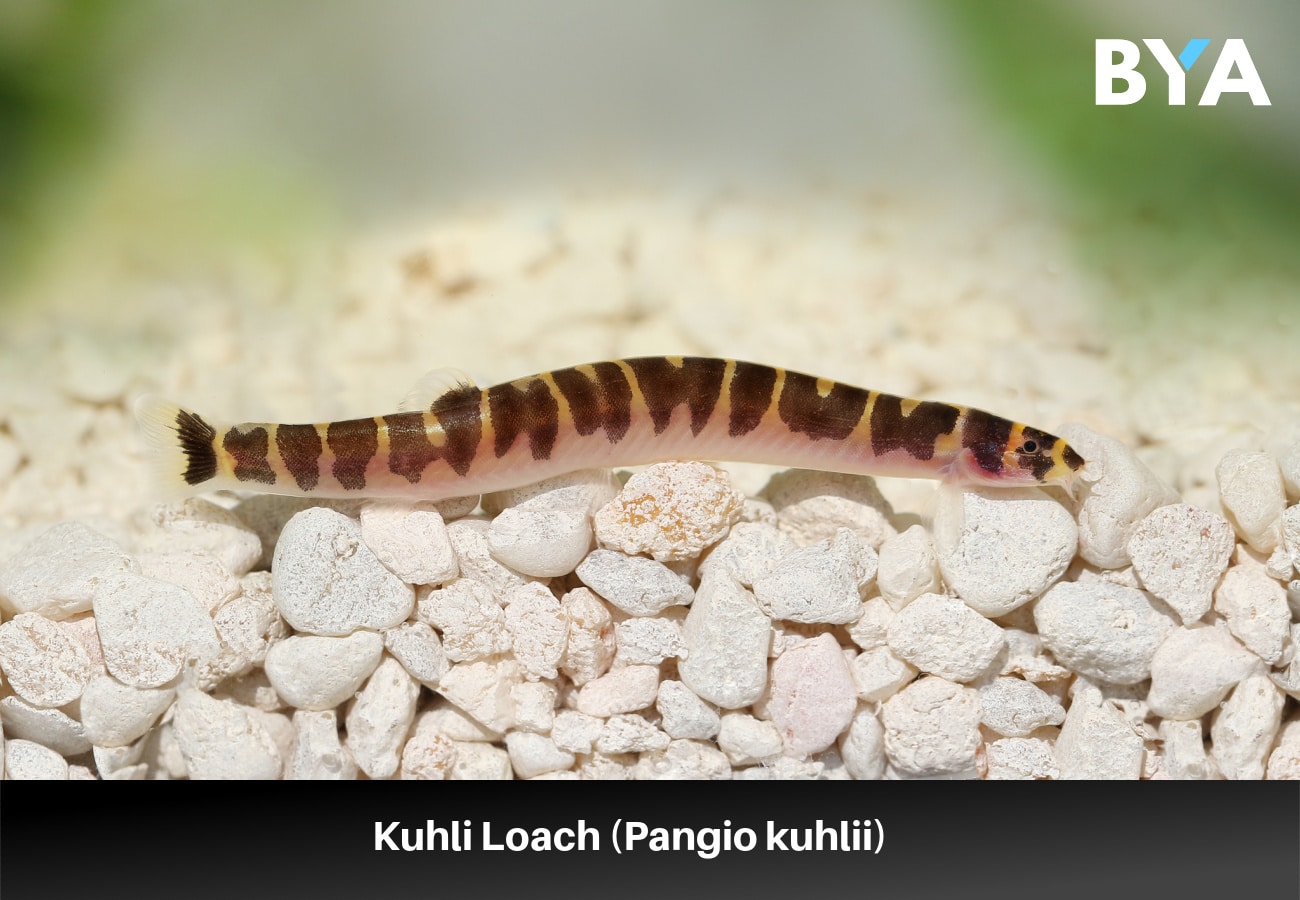
- Size: 3-5 in (7.6-12.7 cm)
- Aquarium Size: 20+ gallons
- Temperature Requirements: 74-80°F (23.3-26.7°C)
- pH Requirements: 6.0-6.5
- Swimming Level: Bottom
- Temperament: Peaceful
Kuhli loaches are easier to keep than other loaches because they stay small and are peaceful. Some larger loach species can become quite aggressive and need much more space.
Kuhli loaches are happy to hang out at the bottom of the aquarium, spending most of their day under rocks.
Kuhli loaches have long, slender bodies that resemble eels and snakes. Some have purely dark bodies, while others have bands of bright yellow to break up the dark brown.
These loaches are helpful because they snack on pest snails.
Kuhli loaches are enjoyable because they become active in numbers. They are schooling fish that feel most comfortable in groups of at least six.
Nocturnal fish, aquarists often see kuhli loaches zipping about the tank at night.
Kuhli loaches are mostly easy to care for, though they have some specific needs.
Stick with a soft substrate, like sand or fine gravel, as they like to dig. Loaches are “scaleless” fish, and their skin can damage easily.
Also, keep a lid on their tank, as they tend to jump.
10. Mollies (Poecilia Spp.)
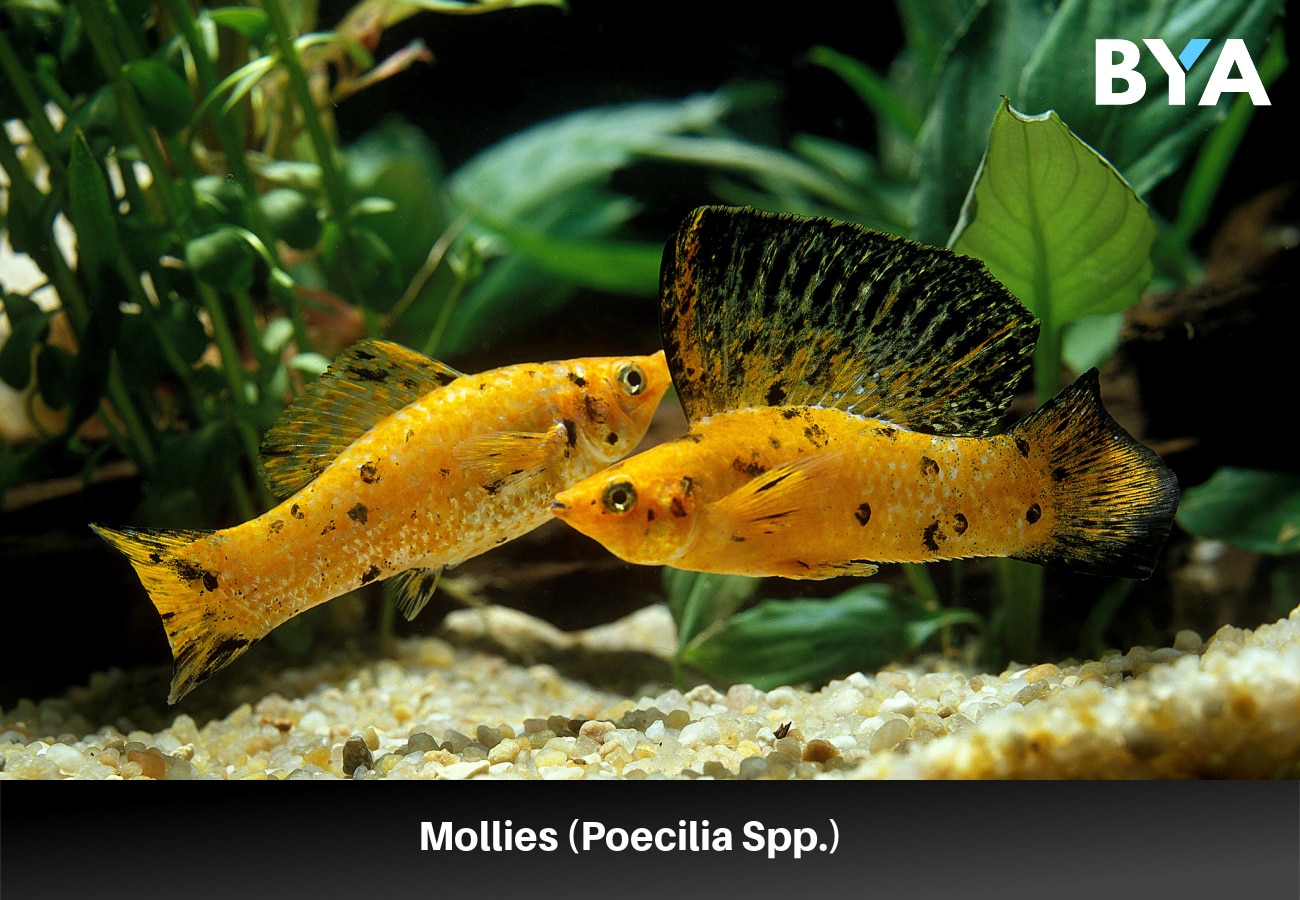
- Size: 2-8 in — varies by species
- Aquarium Size: 20+ gallons
- Temperature Requirements: 70-78°F (21.1-25.6°C)
- pH Requirements: 7.0-8.5
- Swimming Level: Middle to Top
- Temperament: Peaceful
Mollies are among the best freshwater fish for beginners because they are easygoing. They are tropical species that can handle various temperatures and pH levels.
Mollies are one of the only freshwater aquarium species that can also live in brackish water. Hobbyists love adding mollies to their fiddler crab tanks. There aren’t many other fish available that can live in slightly salty conditions.
These livebearers are peaceful and non-nippy. They get along with many peaceful community species.
Their larger size allows them to live with some semi-aggressive species. While they won’t pick a fight or bully other fish, they aren’t afraid to stand up for themselves.
11. Neon Tetras (Paracheirodon innesi)
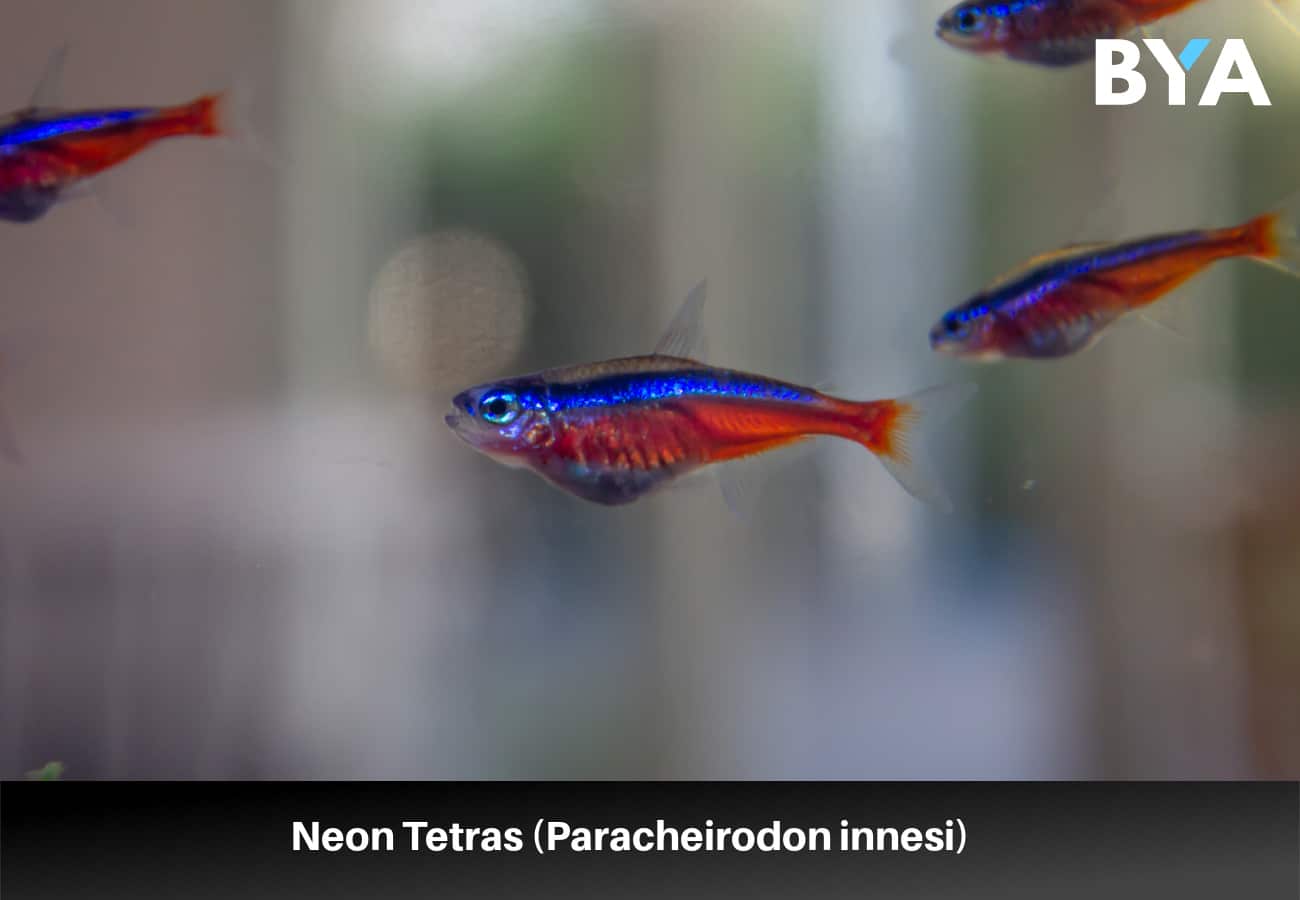
- Size: 1-1.5 in (2.5-3.8 cm)
- Aquarium Size: 10+ gallons
- Temperature Requirements: 75-80°F (23.9-26.7°C)
- pH Requirements: 4.0-7.0
- Swimming Level: Middle to Top
- Temperament: Peaceful
Neon tetras are famous for their iridescent blue and red bodies.
Most tetras are nippy. Neons don’t exhibit such behavior and work well with most community fish.
Neon tetras are tiny fish that work well in nano tanks of only ten gallons. They also do well in larger tanks, especially in large schools where they feel safest.
Neon tetras are hardy animals that can handle a wide range of parameters. In the wild, they live in blackwater streams where the pH may drop as low as 4.0 to 5.0. They do well in pH levels as low as 4.0 and as high as 7.0.
Their only restriction is that they are tropical fish that must live in warm water.
12. Dwarf Otocinclus Catfish (Otocinclus vittatus)
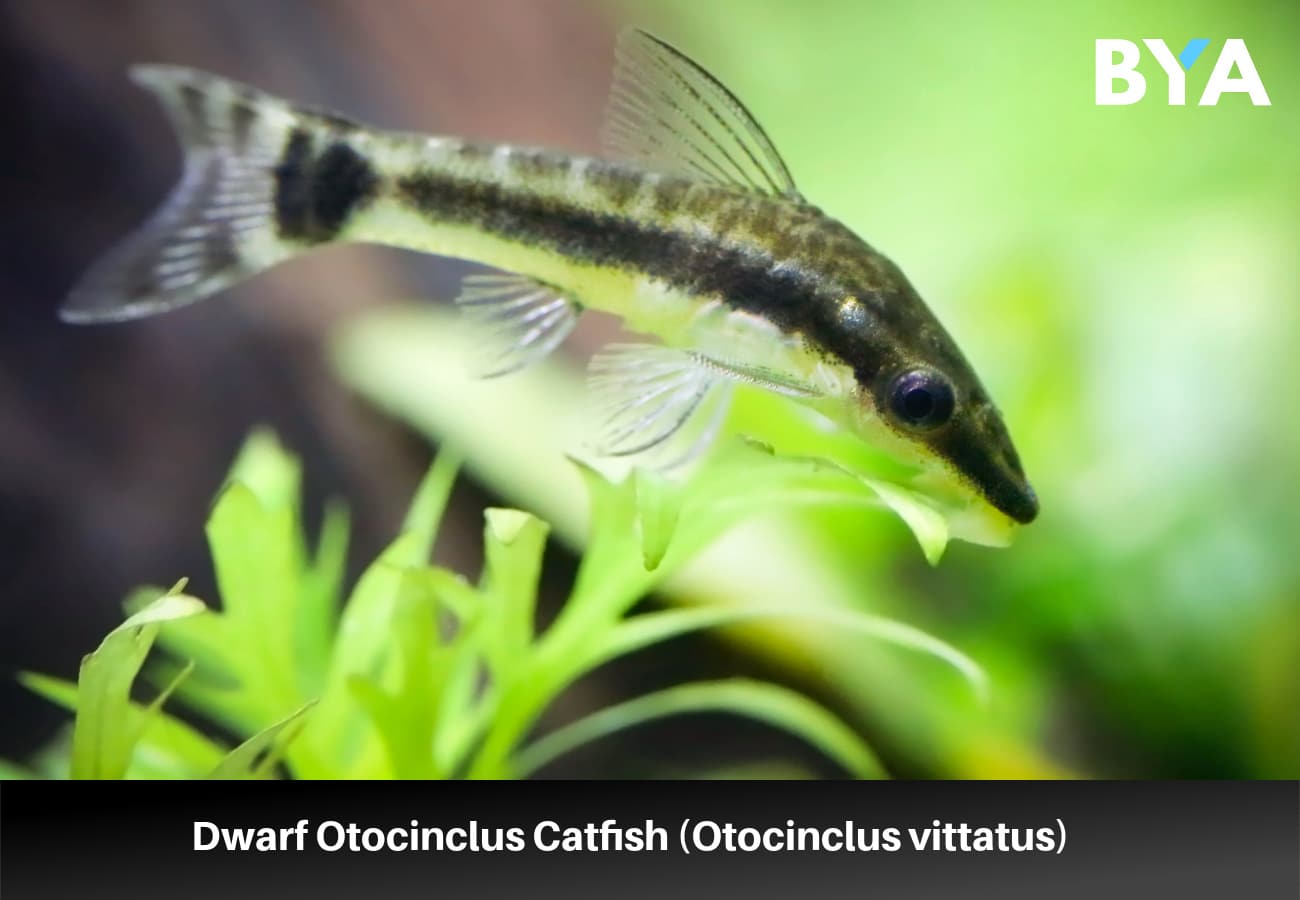
- Size: Up to 2 in (5.1 cm)
- Aquarium Size: 15+ gallons
- Temperature Requirements: 72–79°F (22–26°C)
- pH Requirements: 6.8-7.5
- Swimming Level: Bottom
- Temperament: Peaceful
Otocinclus catfish are great for hobbyists that prefer a “suckermouth” over Corydoras.
They are tiny fish that do well in nano aquariums, though they must be in groups to feel safe.
Otocinclus stick to the side of the aquarium and scrape off algae.
The main thing to remember is that while they are great algae eaters, otos need other food. Feed them bottom feeder pellets in the early morning or late at night when the other fish are less active.
Otos need warm water, though they are less picky about their pH levels.
They are one of the most peaceful species available and will not cause a problem in the tank. They spend most of their time at the bottom of the tank, out of the way of any other fish.
13. Platies (Xiphophorus maculatus)
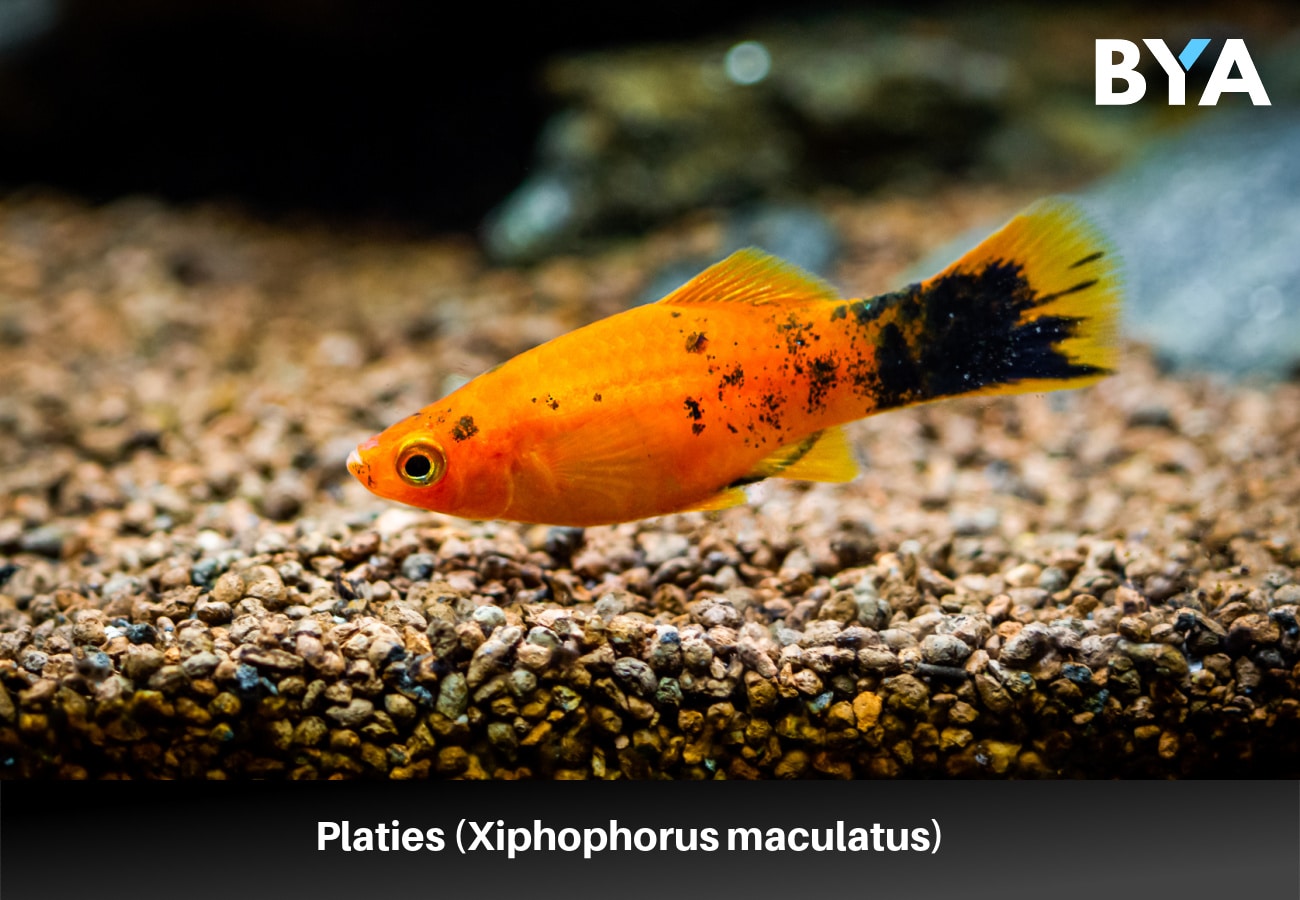
- Size: 2-3 in (5-7 cm)
- Aquarium Size: 20+ gallons
- Temperature Requirements: 70-82°F (21-28°C)
- pH Requirements: 6.8-8.5
- Swimming Level: Middle to Top
- Temperament: Peaceful
Like mollies and guppies, platies are peaceful live-bearing fish. They are hardy and can handle various water parameters.
Platies are tropical fish that prefer higher temperatures and neutral to alkaline water.
Their docile personalities make them good tank mates for various community species. Due to their smaller size, they don’t do as well as mollies with semi-aggressive species.
Hobbyists often prefer platies to mollies because they are more colorful and don’t take up as much space. Mollies are more known for their large fins, while platies are famous for their colors. Platies come in many vibrant hues and interesting patterns.
Like guppies and mollies, hobbyists should be cautious about babies. Those new to the fish-keeping hobby will be better off sticking to one gender.
14. Siamese Algae Eaters (Crossocheilus oblongus)
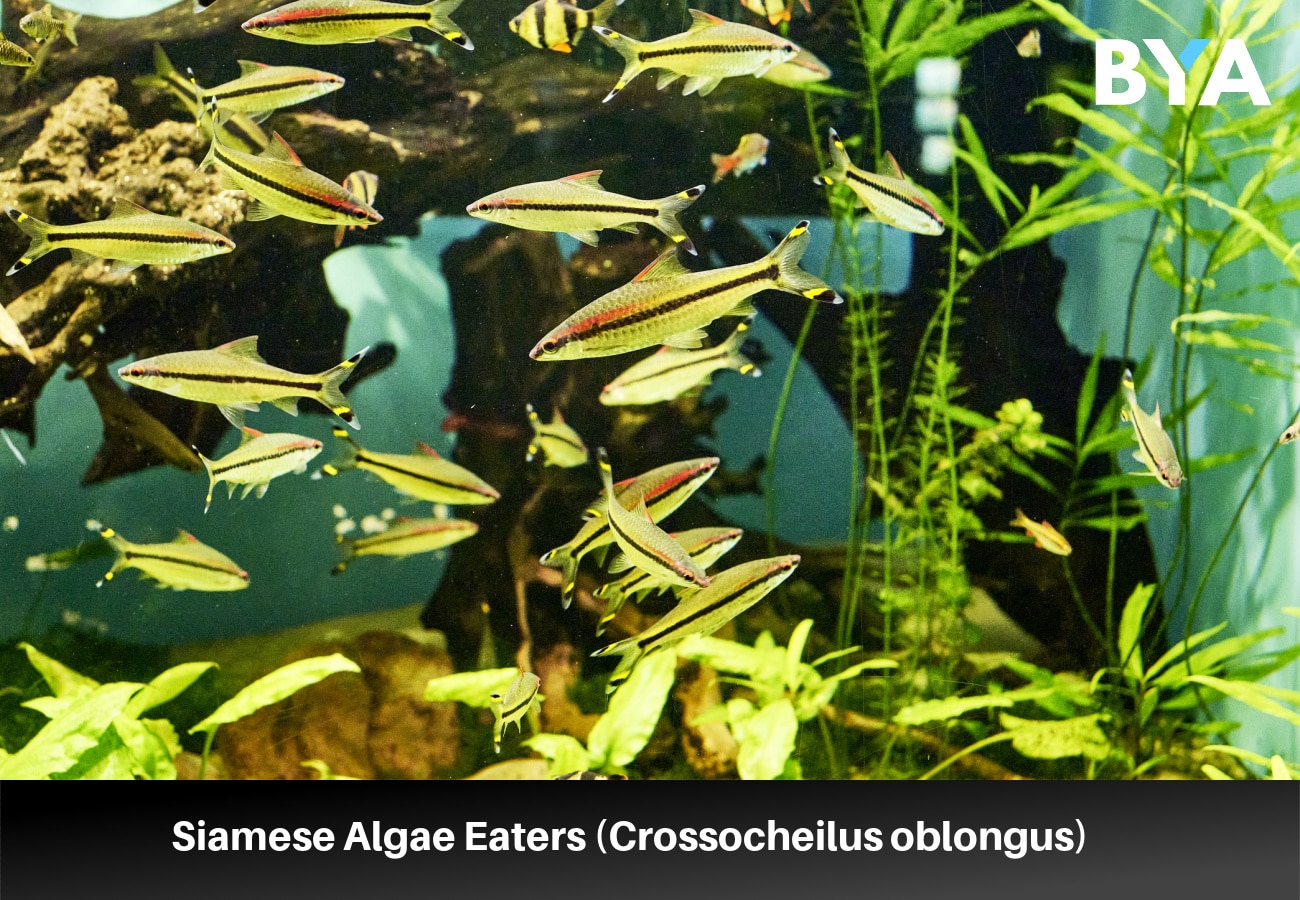
- Size: Up to 6 in (15.2 cm)
- Aquarium Size: 30+ gallons
- Temperature Requirements: 72-82°F (22.2-27.8°C)
- pH Requirements: 6.5-8.0
- Swimming Level: Bottom
- Temperament: Peaceful
Siamese algae eaters are a favorite amongst hobbyists. They are easy to care for, peaceful, and great algae eaters.
These fish grow much larger than many on this list and need more swimming space.
They aren’t very picky about their temperature or pH requirements and won’t pick fights with other fish. They mostly stay at the bottom of the tank, where the other fish won’t bother them.
Siamese algae eaters are one of the best algae-eating fish available. Remember that they still need other foods to supplement their diet.
15. White Cloud Mountain Minnows (Tanichthys albonubes)
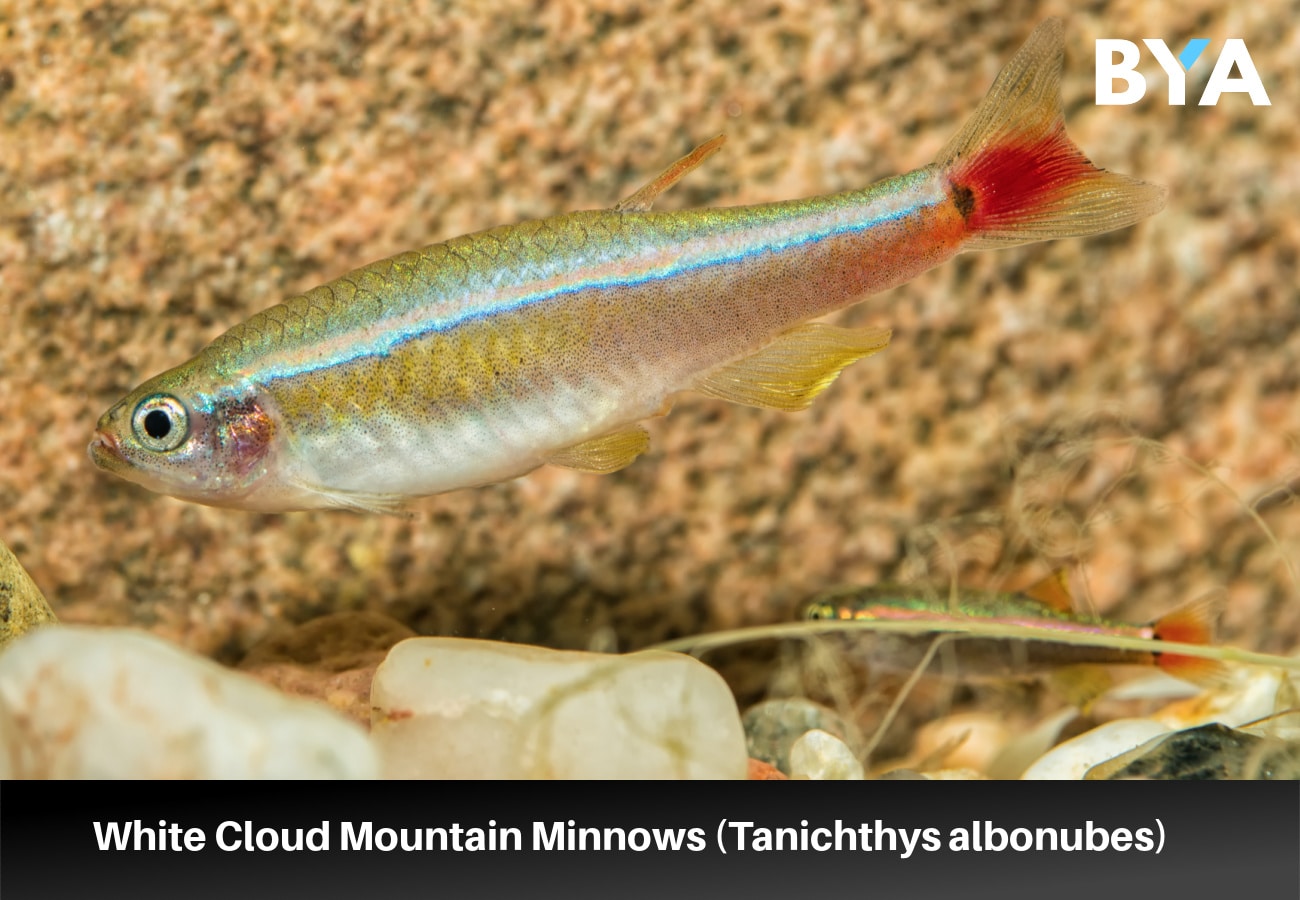
- Size: 1.5 in (3.8 cm)
- Aquarium Size: 10+ gallons
- Temperature Requirements: 60-72°F (15.6-22.2°C)
- pH Requirements: 6.0-8.0
- Swimming Level: Middle to Top
- Temperament: Peaceful
White cloud mountain minnows are easy because they prefer cold water and don’t need a heater. Room temperature is usually suitable for these fish. Hobbyists don’t have to be as cautious about water temperature.
These minnows do well with a wide pH range. They can handle slightly acidic to alkaline water.
Many beginners enjoy these easy fish because they are peaceful and colorful. They should live in schools of at least six individuals. Their rich red fins look better in larger schools. They get along well with other peaceful coldwater fish.
White cloud mountain minnows are one of the easiest fish to feed; they are not picky about food. These minnows are happy with a diet mainly comprised of pellets or flakes. They appreciate an occasional snack of live, frozen, or freeze-dried foods.
16. Zebra Danios (Danio rerio)
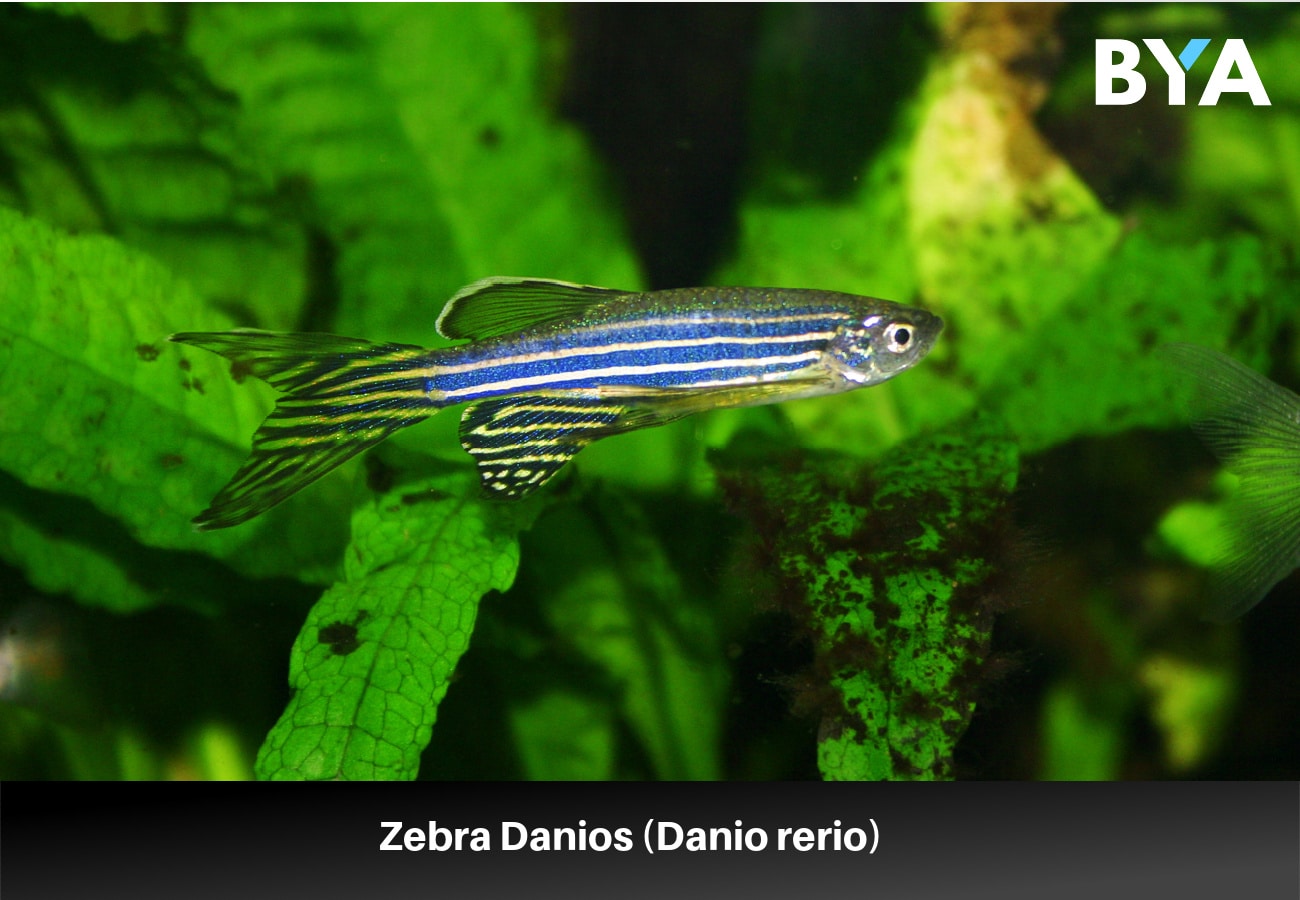
- Size: 1.5 in (3.8 cm)
- Aquarium Size: 15+ gallons
- Temperature Requirements: 64-75°F (17.8-23.9°C)
- pH Requirements: 7.0-7.8
- Swimming Level: Middle to Top
- Temperament: Mostly peaceful — can be nippy
Zebra danios are among the easiest fish an aquarist can buy. They are hardy fish that can tolerate a wide range of parameters and fluctuations. They handle changing water conditions better than most other species. We still recommend keeping the water as stable as possible.
Some experienced hobbyists prefer doing a “fish-in” cycle when setting up a new tank. A “fish-in” cycle refers to beginning the nitrogen cycle by adding fish to a brand-new tank.
Zebra danios are one of the species most likely to survive a “fish-in” cycle.
Besides their hardiness, zebra danios are popular for their aesthetics and personalities. They have black and white stripes that resemble zebras and long, slender bodies.
As active schooling fish, they zip around their tank, providing the perfect entertainment.
What Makes Some Species Of Fish Easier To Care For?
A fish’s needs, personality, and ability to handle stress determine how easy it is to care for.
Tank Size
Most of these fish need 15 to 30 gallons of water.
These size tanks are easier to care for than smaller ones. It’s easier to keep the water parameters stable in a larger tank.
Tanks of this size also need less maintenance than tanks over 30 gallons.
Hardiness
A hardy fish is easier to care for than a sensitive fish. They can handle a wider range of parameters and aren’t as bothered by fluctuations.
For example, Discus are highly sensitive and not suitable for beginners.
Personalities
Peaceful fish are far easier to care for than those with attitudes. Mild fish can live in community tanks with other peaceful species.
Diet
Most of the fish on this list are hearty eaters that are not picky. While they need nutritious foods, they are quick to eat almost anything.
Why Are “Easy” Fish Good?
“Easy” fish are great because they need less care and maintenance than other fish.
They are ideal for those that don’t want to, or aren’t ready to, care for more challenging fish.
Beginners
As beginners, hobbyists won’t want to jump into more difficult fish. Doing so can be overwhelming and may cause the fish to die.
The fish listed above are ideal for beginners to “get their feet wet” in the fish-keeping hobby.
Children
Children love the idea of having fish as pets. They rarely understand how difficult they can be to care for.
Easier fish are great for teaching kids responsibility. They are also better for the parents, who will inevitably end up doing some of the care.
Low On Time & Money
Hobbyists don’t need a lot of time or money to enjoy fish.
“Easy” fish are often much more affordable than more complicated species. They also tend to be hardier and need less maintenance.
Here’s What All Fish Need, Even If They’re “Easy”
No matter how easy the fish are, they all need basic care. For example, owners should never place fish in a bowl with no filter.
A Filter
A filter is the most basic and essential piece of equipment that every aquarium needs.
Filters clean the water and remove toxins. They are home to beneficial bacteria that keep the water from becoming toxic.
A Heater
Tropical fish need a heater to keep their water warm to stay healthy. Cold water lowers a tropical fish’s immune system, which can lead to illness and death.
Decorations
All fish need decorations that they can hide in to feel safe. They also provide enrichment so the fish don’t get bored.
Nutritious Food
Hobbyists must look into the food their fish need. Doing so ensures they’re giving the fish a healthy, well-rounded diet. A good diet helps lengthen fish’s lifespans.
Lighting
Lighting mimics the day-night cycle, which is vital to a fish’s health.
Goldfish — Not A Beginner Fish
Many sources list goldfish as a good “easy” or “beginner” fish. Despite the many claims, it isn’t true.
Goldfish are NOT easy fish. Their portrayal as simple fish to care for leads to the early deaths of many of these fish.
So many new hobbyists buy a goldfish to simply place it in a small bowl with no filter or heater. Although the bowl stunts their growth, goldfish are meant to grow very large.
Stunting their growth is detrimental to their health and causes them to die after one to three years. Healthy goldfish should live for at least 15 years.
Goldfish need experienced owners because of their size and metabolism. They need to eat more often than other fish; they also create more waste.
Goldfish need no less than 30 gallons of water, and the tank needs weekly cleaning to stay healthy.
